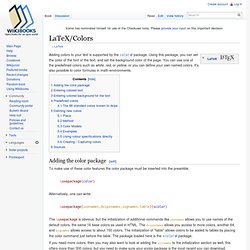

LaTeX. LaTeX (/ˈleɪtɛk/ LAY-tek or /ˈlɑːtɛk/ LAH-tek[1]) is a document preparation system and document markup language.

It is the de facto standard for the communication and publication of scientific documents in many fields, including mathematics, physics, and computer science.[2] LaTeX uses the TeX typesetting program for formatting its output, and is itself written in the TeX macro language. LaTeX is not the name of a particular editing program, but refers to the encoding or tagging conventions that are used in LaTeX documents. LaTeX is widely used in academia.[3][4] It is also used as the primary method of displaying formulas on Wikipedia. LaTeX can be used as a primary or intermediate format, e.g., translating DocBook and other XML-based formats to PDF. LaTeX was originally written in the early 1980s by Leslie Lamport at SRI International.[5] The current version is LaTeX2e (styled as LaTeX2ε).
Typesetting system[edit] Examples[edit] Note how the equation for. LaTeX/Colors. Adding colors to your text is supported by the color package.

Using this package, you can set the color of the font of the text, and set the background color of the page. You can use one of the predefined colors such as white, red, or yellow, or you can define your own named colors. It's also possible to color formulas in math-environments. Adding the color package[edit] To make use of these color features the color package must be inserted into the preamble. Alternatively, one can write: The \usepackage is obvious, but the initialization of additional commands like usenames allows you to use names of the default colors, the same 16 base colors as used in HTML.
If you need more colors, then you may also want to look at adding the x11names to the initialization section as well, this offers more than 300 colors, but you need to make sure your xcolor package is the most recent you can download. Entering colored text[edit] The simplest way to type colored text is by: Another possible way by where: Ltxprimer-1.0. Doxygen. Generate documentation from source code Doxygen is the de facto standard tool for generating documentation from annotated C++ sources, but it also supports other popular programming languages such as C, Objective-C, C#, PHP, Java, Python, IDL (Corba, Microsoft, and UNO/OpenOffice flavors), Fortran, VHDL, Tcl, and to some extent D.

Doxygen can help you in three ways: It can generate an on-line documentation browser (in HTML) and/or an off-line reference manual (in ) from a set of documented source files. There is also support for generating output in RTF (MS-Word), PostScript, hyperlinked PDF, compressed HTML, and Unix man pages. The documentation is extracted directly from the sources, which makes it much easier to keep the documentation consistent with the source code. Doxygen is developed under Mac OS X and Linux, but is set-up to be highly portable. Doxygen license Copyright © 1997-2016 by Dimitri van Heesch. Sponsored links(not related to doxygen) C++ Coding Style, Standards, Practices and dOxygen. Coding practices should be in place to maintain a consistancy among software projects to enforce a disciplines which improves the quality of software, improves reuseability due to more generic interfaces and good documentation, results in software with fewer bugs which is easier to use and maintain.

Camel-case is the practice of changing the letter to upper case to denote the start of a new word. This allows the name to be shorter because no separator character (i.e. "_" used between words.) The Camel-case practice uses a "_" separator between upper case constants used in words. Examples: VariableForTheBlueTeam variableForTheBlueTeamInstantiation SPAM_Eliminator "Hungarian" prefixes: Some of these are discussed in the book "Code Complete" and others I have seen in corporate coding standards.
Hungarian Examples: ppachVarName: pointer to a pointer of an array of characters. m_ppachVarName: class member variable which is a pointer to a pointer of an array of characters. Example: Create a list: